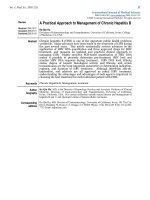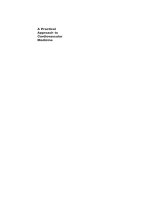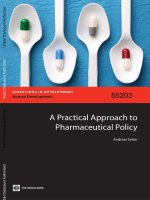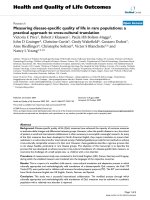Ebook A practical approach to clinical echocardiography Part 1
Bạn đang xem bản rút gọn của tài liệu. Xem và tải ngay bản đầy đủ của tài liệu tại đây (6.64 MB, 221 trang )
A Practical Approach to
Clinical Echocardiography
A Practical Approach to
Clinical Echocardiography
Jagdish C Mohan MD DM FASE
Director of Cardiac Sciences
Fortis Hospital
Shalimar Bagh, New Delhi, India
Foreword
Bijoy K Khandheria
®
JAYPEE BROTHERS MEDICAL PUBLISHERS (P) LTD
New Delhi • London • Philadelphia • Panama
®
Jaypee Brothers Medical Publishers (P) Ltd
Headquarters
Jaypee Brothers Medical Publishers (P) Ltd
4838/24, Ansari Road, Daryaganj
New Delhi 110 002, India
Phone: +91-11-43574357
Fax: +91-11-43574314
Email:
Overseas Offices
J.P. Medical Ltd
83, Victoria Street, London
SW1H 0HW (UK)
Phone: +44-2031708910
Fax: +02-03-0086180
Email:
Jaypee-Highlights.
medical publishers Inc
City of Knowledge, Bld. 237
Clayton, Panama City, Panama
Phone: +1 507-301-0496
Fax: +1 507-301-0499
Email:
Jaypee Brothers
Medical Publishers (P) Ltd
17/1-B Babar Road, Block-B
Shaymali, Mohammadpur
Dhaka-1207, Bangladesh
Mobile: +08801912003485
Email:
Jaypee Brothers
Medical Publishers (P) Ltd
Shorakhute, Kathmandu
Nepal
Phone: +00977-9841528578
Email:
Jaypee Medical Inc.
The Bourse
111 South Independence Mall East
Suite 835, Philadelphia, PA 19106, USA
Phone: +1 267-519-9789
Email:
Website: www.jaypeebrothers.com
Website: www.jaypeedigital.com
© 2014, Jaypee Brothers Medical Publishers
The views and opinions expressed in this book are solely those of the original contributor(s)/author(s) and do not necessarily represent those of
editor(s) of the book.
All rights reserved. No part of this publication may be reproduced, stored or transmitted in any form or by any means, electronic, mechanical,
photocopying, recording or otherwise, without the prior permission in writing of the publishers.
All brand names and product names used in this book are trade names, service marks, trademarks or registered trademarks of their respective
owners. The publisher is not associated with any product or vendor mentioned in this book.
Medical knowledge and practice change constantly. This book is designed to provide accurate, authoritative information about the subject matter
in question. However, readers are advised to check the most current information available on procedures included and check information from the
manufacturer of each product to be administered, to verify the recommended dose, formula, method and duration of administration, adverse effects
and contraindications. It is the responsibility of the practitioner to take all appropriate safety precautions. Neither the publisher nor the author(s)/
editor(s) assume any liability for any injury and/or damage to persons or property arising from or related to use of material in this book.
This book is sold on the understanding that the publisher is not engaged in providing professional medical services. If such advice or services are
required, the services of a competent medical professional should be sought.
Every effort has been made where necessary to contact holders of copyright to obtain permission to reproduce copyright material. If any have been
inadvertently overlooked, the publisher will be pleased to make the necessary arrangements at the first opportunity.
Inquiries for bulk sales may be solicited at:
A Practical Approach to Clinical Echocardiography
First Edition: 2014
ISBN 978-93-5152-140-2
Printed at:
Dedicated to
Vineet, my soul-mate for the last thirty-six years
Foreword
The field of cardiovascular ultrasound continues to explode with an increase in applications and rapid
explosion in technological advances. It was not too long that the world celebrated the 50th anniversary of
cardiac ultrasound. The remarkable progress continues, and the evolution to revolution has yet to see a stop.
With ever-increasing applications and explosion of technology comes the need to transmit this
information in an easy-to-understand, easy-to-digest manner. To this end, Prof Jagdish C Mohan has
exploited the method of making difficult things easy in this book. The book is eminently readable. Strength, weakness
and caveats of every important echo-Doppler observation have been provided. The images and the illustrations are
excellent with extensive labeling for easy understanding. There is less emphasis on bibliography and more on practical
tips. Although there are no separate chapters on transesophageal echocardiography and real-time 3D imaging, these
have been well covered in individual sections wherever appropriate. The same principle has been applied to contrast
echocardiography.
There is little doubt that cardiovascular ultrasound will continue its revolution, and play an important role in the
practice of cardiology as well as medicine. This book compiled by Prof Jagdish C Mohan is a welcome addition to the
various sources of education in this field. It is a must-read book for those wishing to practice the art and science of
cardiovascular ultrasound.
Bijoy K Khandheria MD FACP FAHA FACC FESC FASE
Adjunct Clinical Professor of Medicine
University of Wisconsin, School of Medicine and Public Health
Director, Echocardiography Services
Aurora St Luke’s Medical Center, Milwaukee, Wisconsin, USA
Director, Echocardiography Center for Research and Innovation
Aurora Research Institute, Milwaukee, Wisconsin, USA
Past President, American Society of Echocardiography
Former Chair of Cardiovascular Disease, Mayo Clinic, Arizona
Former Professor of Medicine, Mayo Medical School
Preface
Echocardiography is the most commonly used imaging technique at bedside, in OR, in outpatients and in community
screening. It is highly portable, noninvasive, repeatable, inexpensive and easily accessible. When used appropriately
after some experience, it has inherent internal validation unlike many other imaging modalities. Clinicians using this
technique transcend boundaries of specialties. More and more physicians want to learn and practice it. Despite these
obvious advantages, this modality remains incompletely utilized. There are several learning modules in capsule form
and a multitude of books which claim to make a person expert in short time. In these, either there is over-simplification
or meaningless convoluted and complicated equations and biophysical complexity. At fringes, are clinicians who have
used this technique year after year for assessment of left ventricular function only. Echocardiography represents a
strange mixture of several features which have proven prime-time use and an equally numerous techniques which have
yet to show clinical utility despite extensive research work spanning decades. There is an urgent need to promote that
part of science which has robust validation. What clinicians require needs to be emphasized with clarity. Novices often
get unnerved by the available applications on the systems which are more to stand up to the competition rather than
of tangible clinical value. However, extensive research has shown applicability of a lot of echocardiographic knowledge
and information in day-to-day evidence-based medicine. Quantitative and semi-quantitative protocols are gaining
ground because these make serial follow-up easily. This book is an attempt to make echocardiography simple, practical
and easily usable with reproducible data. Unnecessary and impractical details have been omitted. I would welcome
suggestions to make it more readable and meaningful.
Jagdish C Mohan
Acknowledgments
I appreciate the contribution of M/s Jaypee Brothers Medical Publishers (P) Ltd., New Delhi, India, in making this
project a success. In particular, Ms Chetna Malhotra Vohra (Senior Manager–Business Development) for her belief in
our groups’ ability to deliver and Saima Rashid (Development Editor) who did very well in making sure we catch-up with
the deadline.
Contents
Section 1: Fundamentals of Echocardiography
1.Echocardiography: Basic Principles, Technique, Display and Interpretation
3
• Ultrasound Physics 3
• Ultrasound Beam 7
2. Hemodynamic Evaluation by Echo-Doppler Techniques
•
•
•
•
•
•
•
•
•
•
•
•
•
24
Hemodynamic Evaluation 24
Doppler Principle for Estimating Velocity 25
Ohm’s Law of Fluids (The Hagen–Poiseuille Equation) 27
The Bernoulli’s Equation 28
Continuity Equation 28
Effective Orifice Area 30
Vena Contracta 31
Pressure Recovery 33
Ventriculovalvular Impedance 34
Proximal Isovelocity Surface Area and Volumetric Measurements 34
Pressure Half-Time 36
Lv Dp/Dt 39
Estimation of Pulmonary Artery Pressures and Pulmonary Vascular Resistance 39
Section 2: Valvular Heart Disease
3. Mitral Stenosis
45
• Anatomy of the Mitral Valve 45
4. Mitral Regurgitation
64
• Functional Morphology of Mr 64
5. Aortic Valve Stenosis
•
•
•
•
•
Anatomy of Trileaflet Aortic Valve 83
Unicuspid Aortic Valve 85
Bicuspid Aortic Valve 85
Quadricuspid Aortic Valve 86
Anatomy of Aortic Stenosis 86
83
xiv
A Practical Approach to Clinical Echocardiography
•
•
•
•
•
•
6. Aortic Valve Regurgitation
•
•
•
•
•
•
•
•
•
•
•
110
Functional Morphology of the Tricuspid Valve 110
Conditions Affecting Tricuspid Valve 113
Remodelling in Tricuspid Regurgitation 114
Functional Tr 114
Organic Tricuspid Valve Disorders 115
Tricuspid Valve Stenosis 120
Assessment of Severity of Tr 121
Vena Contracta 121
Proximal Isovelocity Surface Area Method 122
Anterograde Velocity of Tricuspid Inflow 122
Hepatic Vein Flow in Assessment of Tr 123
8. Pulmonary Valve
•
•
•
•
•
•
98
Hemodynamics of Aortic Regurgitation 98
Functional Anatomy of Aortic Regurgitation 100
Detection of Aortic Regurgitation by Echo-Doppler Techniques 102
Volumetric Severity of Aortic Regurgitation 104
Color Flow Doppler Evaluation of Aortic Regurgitation 104
Aortic Regurgitation Assessment by Vena Contracta 105
Proximal Isovelocity Surface Area Flow Convergence Method 105
Diastolic Flow Reversal in the Descending Aorta and Severity of Aortic Regurgitation 106
Pressure Half-time of Aortic Regurgitation Signal 107
M-mode Color Flow Propagation Velocity 108
Summary of Aortic Regurgitation Assessment by Echo-Doppler Methods 108
7.Tricuspid Valve
•
•
•
•
•
•
•
•
•
•
•
Planimetry of the Aortic Valve Area on Aortic Stenosis 87
Hemodynamics of Aortic Valve Stenosis 88
Technical Tips 90
Low-gradient, Low-flow Aortic Valve Stenosis 93
Paradoxical Low-flow as with Preserved Ejection Fraction 95
Subaortic Stenosis 95
126
Anatomy of the Pulmonary Valve 126
Pulmonary Valve Disorders 127
Transesophageal Echocardiography in Pulmonary Stenosis 133
Consequences and Associations of Pulmonary Stenosis 134
Assessment of Pulmonary Regurgitation 134
Consequences of Pulmonary Regurgitation 136
9. Evaluation of Prosthetic Heart Valves
• Ball-in-cage Valve 138
• Tilting or Mono-disk Valve 139
138
Contents
•
•
•
•
•
•
•
•
•
•
•
Bileaflet Prosthetic Valves 140
Bioprosthesis 141
Hemodynamic Assessment of Prosthetic Valves 141
Technical Considerations 148
Microbubble Formation (Cavitation) 152
Prosthetic Valve Dysfunction 152
Bioprosthetic Degeneration 152
Prosthetic and Paraprosthetic Regurgitation 153
Paraprosthetic Regurgitation 154
Prosthetic Valve Stenosis 155
Tricuspid and Pulmonary Prosthetic Valves 160
Section 3: Systolic and Diastolic Function
10. Left Ventricular Systolic Function
165
• Morphology of the Left Ventricle 165
• Limitations 186
11. Echocardiographic Assessment of Right Ventricular Function:
Methods and Clinical Applications
•
•
•
•
•
Peculiarities of the Right Ventricle 189
Function Parameters 190
Right Ventricle Diastolic Function and Pressures 193
Tricuspid Annular Peak Systolic Velocity 198
Right Ventricle Strain and Strain Rate Analysis 200
12. Diastolic Function
•
•
•
•
•
•
•
•
•
•
•
•
•
•
•
•
•
•
189
Physiology of Diastole 204
Factors Contributing to Diastole 205
Significance of Diastolic Function 205
Isovolumic Relaxation Time 206
Rapid Filling Phase 207
Deceleration Time of Early Filling Wave (Mitral E- and Pulmonary D-Waves) 207
Diastasis 208
Atrial Kick or Contribution 209
Tissue Motion and Diastolic Function 209
Left Atrial Volume and Diastolic Function/Dysfunction 210
How to Perform a Study Focusing on Diastolic Function 211
Mitral Inflow Velocities 212
Mitral Annular Velocities 214
How to Obtain Annular Tissue Velocities 216
Pulmonary Vein Flow and Diastolic Function 218
Mitral Flow Propagation by Color M-Mode 221
Longitudinal Strain, Rotation and Untwisting Rate by Acoustic Speckle Tracking 223
Diastolic Stress Test 224
204
xv
xvi
A Practical Approach to Clinical Echocardiography
Section 4: Muscle Mechanics
13.Tissue Doppler Echocardiography: Current Status and Applications
•
•
•
•
•
•
•
•
•
•
•
Concept of Tdi 229
Labeling of Tissue Velocity Waveforms 229
Terms Used in Tissue Doppler Imaging 231
Technical Details of Tdi 231
Myocardial Velocities in Short Axis 234
Internal Dependency of Velocities 235
Fundamental Basis of Tdi 236
Tissue Doppler Data Processing for Deformation Imaging 238
Clinical Utility of Tdi 239
Prognostic Value of Tdi in Diverse Cardiac Disorders 250
Limitations of Tdi 251
14. Deformation Imaging: Theory and Practice
•
•
•
•
•
•
•
•
•
•
•
•
•
•
•
257
Myocardial Deformation 257
Descriptive Terms 261
Acoustic Speckle Tracking 262
Velocity Vector Imaging 264
How to Perform Two-Dimensional Strain Imaging? 266
Effects of Ischemia on Regional Deformation Metrics 268
Early Systolic Longitudinal Lengthening (Paradoxical Longitudinal Systolic Strain) 269
Post-systolic Longitudinal Shortening 270
Paradoxical Strain Patterns 272
Right Ventricular Deformation 273
Left Atrial Function by Deformation Imaging 273
Mechanical Properties of the Aorta 274
Three-dimensional/Four-dimensional Deformation Imaging 274
Clinical Applications of Strain and Strain Rate Imaging 276
Limitations 277
15. Rotation, Twist and Torsion
•
•
•
•
•
•
•
•
•
•
229
Fundamentals of Torsion 280
Echocardiographic Methods of Studying Twist 284
Clinical Applications of Torsion 285
Aging and Torsion 286
Aortic Stenosis, Hypertension and Hypertrophic Cardiomyopathy 286
Heart Failure 287
Constrictive Pericarditis 287
Torsion and Cardiac Resynchronization Therapy 288
Acute and Chronic Ischemia 289
Grades of Diastolic Dysfunction and Twist 290
280
Contents
Section 5: CHD, Aorta and Pericardium
16.Congenital Heart Disease in Adults
•
•
•
•
•
•
•
•
•
•
•
•
•
•
•
•
•
•
Atrial Septal Defect 295
Patent Foramen Ovale 299
Ostium Primum Atrial Septal Defect 299
Sinus Venosus Atrial Septal Defect 300
Common or Single Atrium 300
Ventricular Septal Defect 300
Morphology of Vsd 302
Pathophysiology of Vsd 302
Ebstein’s Anomaly 304
Carpentier Classification of Ebstein’s Anomaly 306
Double-Chambered Rv 307
Sinus of Valsalva Aneurysms 308
Tetralogy of Fallot 311
Morphological Variants of Tof 312
Truncus Arteriosus or Common Arterial Trunk 313
Subaortic Membranous Stenosis 314
Physiology and Pathology 314
Transposition of Great Vessels 315
17. Aorta: Congenital and Acquired Disorders
•
•
•
•
•
•
•
•
•
•
•
•
•
318
Structure of Aorta 318
Parts of Aorta 318
Functions of Aorta 320
Normal Aortic Measurements and Imaging Views 321
Etiopathogenesis of Aortic Disorders 322
Congenital Disorders of Aorta 322
Aortic Coarctation 324
Aneurysm of Sinus of Valsalva 325
Aortopulmonary Window 329
Truncus Arteriosus 329
Supravalvular Aortic Stenosis 330
Patent Ductus Arteriosus 330
Acquired Aortopathies 331
18. Pericardial Diseases
•
•
•
•
•
•
295
Echocardiographic Anatomy of Pericardium 343
Pericardial Disorders 344
Acute Pericarditis and Pericardial Effusion 345
Cardiac Tamponade 349
Pericardial Cysts and Masses 353
Pericardial Constriction 353
343
xvii
xviii
A Practical Approach to Clinical Echocardiography
Section 6: Structural Heart Disease
19. Ischemic Heart Disease
•
•
•
•
•
•
•
Myocardial Segment Nomenclature and Coronary Vascular Territory 363
Right Ventricular Segmentation 363
Ischemia and Echocardiographic Imaging 365
Echocardiography in Ihd 369
Evaluation of Myocardial Infarction 369
Mechanical Complications of Myocardial Infarction 370
Stress Echocardiography 377
20.Tumors, Masses and Infection
•
•
•
•
•
•
•
•
•
363
383
Cardiac Manifestations of Masses 383
Cardiac Thrombi and Spontaneous Echo Contrast 384
Cardiac Tumors 385
Echocardiographic Features of Myxoma 387
Papillary Fibroelastoma 388
Malignant Tumors 388
Differential Diagnosis of Cardiac Tumors 389
Infective Endocarditis 389
Points to Remember 392
21.Cardiomyopathies
395
• European Classification of Cardiomyopathies 397
• Summary of Emf Echocardiographic Features 406
Index415
SEction
1
Fundamentals of Echocardiography
Chapters
ÖÖ Echocardiography: Basic Principles, Technique,
Display and Interpretation
ÖÖ Hemodynamic Evaluation by Echo-Doppler Techniques
Chapter
1
Echocardiography: Basic
Principles, Technique,
Display and Interpretation
Introduction
Echocardiography is a technique of generating images of
the heart with the help of ultrasound (like skiagraphy is
performed with X-rays). Echocardiography has become
an integral part of clinical examination with its bedside
mobility and utility. Practice of echocardiography
mandates the following steps:
• Understanding of ultrasound physics
• Knowledge of the instrumentation
• Acquisition skills
• Interpretative skills
• Sound knowledge of cardiovascular anatomy and
physiologies
• Adequate knowledge of common cardiac pathology
• Reporting, storage and retrieval skills.
Ultrasound behaves very differently when it passes
through any tissue. Many of the objects and artifacts seen
in ultrasound images are due to the physical properties
of ultrasonic beams, such as reflection, refraction,
diffraction and attenuation. Indeed, physical artifacts
are an important element in clinical diagnosis (Fig. 1.1).
Appreciating the phenomena created by ultrasound may
greatly benefit the patient in terms of increased accuracy
of interpretation and diagnosis. The ultrasound wave
created for sending through the tissues is called incident
wave. This is the wave whose behavior is changed by the
tissue.
Fig. 1.1: Behavior of the sound waves. Sound wave after striking a
surface gets reflected as well as transmitted into the other medium in a
different direction (refracted). Total internal reflection without transmission occurs if it strikes the interface at 90°.
ULTRASOUND PHYSICS
Sound
Sound is a form of mechanical energy that consists of waves
of compression and decompression of the transmitting
medium, travelling at a fixed velocity (Figs 1.2 and 1.3).
Sound is an example of longitudinal waves oscillating
back and forth in the direction the sound travels,
thus consisting of successive zones of compression
4
Section 1: Fundamentals of Echocardiography
Fig. 1.2: Alternating compression and rarefaction of a medium as
sound passes through it.
Fig. 1.3: Sound as an oscillating wave of mechanical energy.
Compression is accompanied by high pressure and rarefaction by low
pressure.
Why Use Ultrasound in Medicine?
Fig. 1.4: The concept of pulsed ultrasound. If an interface is closure
to the source of ultrasound, more pulses will be received per second
resulting in better resolution.
(high pressure) and rarefaction (low pressure). The
medium particles, however, show both longitudinal and
transverse oscillations.
Longitudinal oscillations: The oscillating particles
of the medium are displaced parallel to the direction of
motion (direction of energy transfer).
Transverse oscillations: The oscillating particles of the
medium are displaced in a direction perpendicular to the
motion of the wave.
Ultrasound: Sound waves with a frequency of 20000
c/s (20 KHz) are labeled ultrasound. Ultrasound used in
medical diagnosis has a frequency of 1–10 MHz.1–3 These
are beyond the capacity of human ear to perceive.
With higher frequencies (shorter wavelengths), the sound
tends to move more in straight lines like electromagnetic
beams and is reflected like light beams. It is reflected by
much smaller objects (because of shorter wavelengths)
and hence gives good spatial resolution. If the wavelength
of the sound is smaller than the object, no noticeable
diffraction occurs.
wavelength = speed/frequency
Frequency: The frequency of an ultrasound wave
consists of the number of cycles or pressure changes that
occur in one second (Fig. 1.2). The units are cycles per
second or hertz (Hz). Frequency is determined by the
sound source only and not by the medium in which the
sound is travelling.
Propagation speed: Propagation speed is the rate
at which sound can travel through a medium and is
typically considered 1,540 m/s for soft tissue. The speed
is determined solely by the medium characteristics like
density and stiffness. Speed is inversely proportional to
density and incompressibility.
Pulsed ultrasound: Pulsed ultrasound describes a
means of emitting ultrasound waves from a source. To
achieve the depth of resolution required for clinical
uses, pulsed beams are used. Typically, the pulses are a
millisecond or so long and several thousands are emitted
per second (Fig. 1. 4).
Ultrasound interaction with tissue: As a beam of
ultrasound travels through a material, various things
happen to it. A reflection of the beam is called an echo,
Echocardiography: Basic Principles, Technique, Display and Interpretation
Fig. 1.5: The concept of an echo.
A
Fig. 1.6: Soft tissue acoustic interface producing some reflection
and more transmission. If a medium has high acoustic impedance,
stronger reflection will occur.
B
Figs 1.7A and B: (A) Tissue interfaces with variable acoustic impedance. Higher impedance produces brighter echo due to more reflection
of ultrasound; (B) Refraction: Bending of the sound wave as it enters another medium. Refraction is associated with decreasing speed and
wavelength.
a critical concept in all diagnostic imaging (Fig. 1.5). The
production and detection of echoes form the basis of the
technique that is used in all diagnostic instruments. A
reflection occurs at the boundary between two materials
provided that acoustic impedance of the materials is
different. This acoustic impedance is a product of the
density and propagation speed.
If two materials have the same acoustic impedance,
their boundary will not produce an echo. If the difference in
acoustic impedance is small, a weak echo will be produced
and most of the ultrasound will carry on through the
second medium. If the difference in acoustic impedance
is large, however, a strong echo will be produced. If the
difference in acoustic impedance is very large, all the
ultrasound will be totally reflected. Typically in soft tissues,
the amplitude of an echo produced at a boundary is only a
small percentage of the incident amplitudes (Fig. 1.6).
Strong reflections or echoes show on the ultrasound
image as white and weaker reflections as gray (Figs 1.7A
and B).
A sound wave will undergo certain behaviors when it
encounters a tissue interface. Possible behaviors include:
• Reflection off the tissue interface
• Diffraction around the interface
• Transmission (accompanied by refraction) into the
interface or new medium (Fig. 1.8)
5
6
Section 1: Fundamentals of Echocardiography
Fig. 1.8: Decreasing wavelength after refraction in the second medium.
Fig. 1.9: Multiple linear shadows (arrows) in front of mitral prosthesis in
transesophageal echocardiographic (TEE) view due to reverberations.
Fig. 1.10: Reverberations shown by the curved arrow resulting in a
mirror-image artifact.
Fig. 1.11: Reflection from a tissue interface at right angle. There is
stronger reflection resulting in brighter echo. Typically, from posterior
pericardium.
Fig. 1.12: Reflection at an angle equal to the angle of incidence
producing less bright echo.
Reflection of sound waves off of surfaces can lead to
one of two phenomena—an echo or a reverberation.
The reception of multiple reflections off of the interface
causes reverberations—the prolonging of a sound
(Figs 1.9 and 1.10).
Angle of incidence: If a beam of ultrasound strikes the
boundary at right angle, it will be reflected parallel to
the transmitting beam and shall produce stronger echo
(Fig. 1.11). If it strikes a boundary obliquely, the
interactions are more complex than for normal incidence
(Fig. 1.12). The echo will return from the boundary at an
angle equal to the angle of incidence. The transmitted
beam will be deviated from a straight line by an amount
that depends on the difference in the velocity of ultrasound
at either side of the boundary. This process is known as
refraction (Figs 1.1 and 1.7).
Echocardiography: Basic Principles, Technique, Display and Interpretation
Fig. 1.13: Reflection from a large interface is called specular
reflection and appears bright while smaller objects (smaller than the
wavelength) produce acoustic scattering.
Reflection is of two types (Fig. 1.13):
1. Specular reflection: is from a large tissue interface
(smooth boundary between media) and produces
bright echoes. These signals are intense and angle
dependent:
2. Acoustic scattering: occurs from smaller objects.
Scattering is responsible for tissue texture. The signals
are less intense and less angle dependent. These
provide tissue signature to the image.
Attenuation
As sound waves travel through a medium (e.g. tissue or
blood), the intensity weakens or attenuates. The degree
of attenuation is expressed in decibels (dB). Absorption
represents a conversion of sound energy to another
form of energy and is the major reason for attenuation.
Attenuation is greater for high-frequency sounds, which
result in higher absorption and more scatter. Attenuation
coefficient is smallest for the fat and maximum for lungs.
Bones also have very high attenuation coefficient.
Penetration
Depth to which an ultrasound beam travels into a tissue
is called penetration. Besides the tissue characteristic,
penetration is largely dependent upon the frequency of
the ultrasound being applied:
Fig. 1.14: Schematic diagram of an ultrasound beam.
Frequency %
Penetration %
1 MHz
40 cm
2 MHz
20 cm
3 MHz
13 cm
5 MHz
8 cm
10 MHz
4 cm
20 MHz
2 cm
ULTRASOUND BEAM
The sound beam is the confined, directional beam of
ultrasound travelling as a longitudinal wave from the
transducer face into the propagation medium. Ultrasound
beams are made of scan lines. These have length (azimuth)
along their long axis and width (elevation) along their
short axis. Beam width should be as narrow as possible to
prevent beam width artifacts and which can be achieved
by using lens. Ultrasound beams are either steered
mechanically or electrically. Both rapidly sweep sound
waves through tissues (Fig. 1.14).
Imaging Using Ultrasound
Image formation requires an ultrasound machine with
appropriate transducers and display, using a cathode-ray
tube or a flat panel.
7









